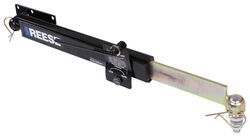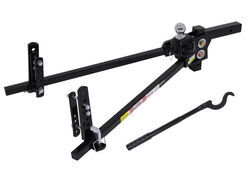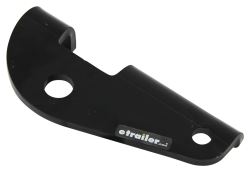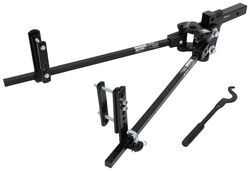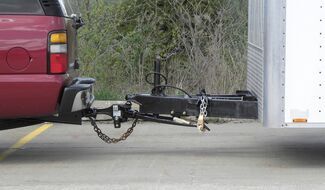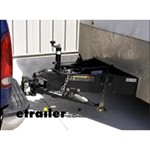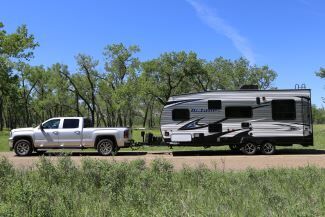
Comparing Trailer Friction Sway Control Device to a Weight Distribution System
Question:
I was wondering what the advantage is to going weight distribution over just a friction sway bar.
asked by: Cory R
Expert Reply:
You'll frequently see sway control combined or integrated into a weight distribution system. A weight distribution system uses flexible spring bars to lever up the rear of the tow vehicle so that the tow vehicle ride height is identical or as near as is possible at the front and the rear axle. A properly set up weight distribution system will eliminate the rear end squat that can be experienced when a trailer is hitched up to the tow vehicle.
Why is having a level ride height important? Two very important reasons. If the rear suspension is compressed, the tow vehicle's headlights will be improperly aimed, which can be dangerous when traveling at night. More importantly- when the rear suspension is compressed, the weight bearing down on the front axle can be reduced. This can be dangerous because the front vehicle brakes do the majority of the braking. If the front axle is un-sprung because of the trailer tongue weight that's being applied to the rear axle, the brakes will be less effective. This can also have a negative effect on steering response. When the weight of whatever you're towing is equal or greater than half the weight of your tow vehicle, using weight distribution is recommended.
A sway control device can be a separate device or one that's incorporated into a weight distribution system. It's job is to keep side to side pivot of the trailer as stiff as possible so the trailer tracks in a straight line behind the tow vehicle. Because the spring bars of a weight distribution system provide a small bit of metal on metal friction at the point where the bars attach to the weight distribution head, a small amount of sway control is provided but it's pretty minimal.
Sway control devices are more often recommended for travel trailers, livestock and horse trailers or enclosed cargo trailers because the sides of these trailers provide a lot of surface area for crosswinds or turbulence from oncoming or passing traffic to act against. A friction sway control unit like # 83660 is recommended for minor to moderate sway. A device like this can be used with or without weight distribution. If you don't have a weight distribution system, you'd need to use a sway control tab like # RP26003 to provide a mounting spot for the friction unit to attach. For trailers longer than 25 feet, using two of the friction sway units is recommended.
For moderate to severe sway, you'd want to use a weight distribution system with an integrated sway control component. The Fastway # FA92-00-0800 that you had looked at is a good example of that kind of system. This particular system is designed for trailers with tongue weights ranging from 400-800 lbs. The Equal-I-zer # EQ37100ET goes a step further in offering additional sway control, both at the points where the bars attach to the weight distributing head and at the brackets where the bars ride on the trailer frame.
To choose the best weight distribution system for you, you need to consider the tongue weight of the fully loaded trailer and the type of trailer. I've linked you to an FAQ article about weight distribution, and one that explains how to determine the tongue weight of your trailer.

Products Referenced in This Question
Reese Friction Sway Control Kit - Economy - by Draw-Tite, Reese and Hidden Hitch
- Accessories and Parts
- Weight Distribution Hitch
- Sway Control Parts
- Reese
more information >
Equal-i-zer Weight Distribution System w/ 4-Point Sway Control - 10,000 lbs GTW, 1,000 lbs TW
- Weight Distribution Hitch
- WD With Sway Control
- Some Sway
- Includes Shank
- Electric Brake Compatible
- Surge Brake Compatible
- Fits 2 Inch Hitch
- Allows Backing Up
- 800 lbs
- 900 lbs
- Equal-i-zer
more information >
Reese Sway-Control Bracket for 2" Ball Mounts - Class III and IV
- Accessories and Parts
- Weight Distribution Hitch
- Adapters
- Sway Control Parts
- Brackets
- Reese
more information >
Product Page this Question was Asked From
Fastway e2 Weight Distribution w/ 2-Point Sway Control - Trunnion - 8,000 lbs GTW, 800 lbs TW
- Weight Distribution Hitch
- WD With Sway Control
- Some Sway
- Includes Shank
- Electric Brake Compatible
- Surge Brake Compatible
- Fits 2 Inch Hitch
- Allows Backing Up
- 600 lbs
- 700 lbs
- Fastway
more information >
Featured Help Information
Instructions
Miscellaneous Media

Continue Researching
- Shop: Reese Pro Round Bar Weight Distribution w Sway Control - Round Bar - 11,500 lbs GTW, 1,150 lbs TW
- Video: Review of Reese Weight Distribution - WD Only - RE44FR
- Search Results: load equalizing hitch
- Shop: Suspension Enhancement
- Video: Review of Fastway Weight Distribution Hitch - e2 1K lbs TW WD With Sway Control - FA94-00-1033
- Video: Equal-i-zer Weight Distribution - WD With Sway Control - EQ37101ET Review
- Video: Reese Friction Sway Control Kit Review
- Shop: Reese Friction Sway Control Kit - Economy - by Draw-Tite, Reese and Hidden Hitch
- Shop: Fastway e2 Weight Distribution w/ 2-Point Sway Control - Round - 2-5/16" Hitch Ball - 10K GTW
- Shop: Fastway e2 Weight Distribution w/ 2-Point Sway Control - Round - 10,000 lbs GTW - Without Shank
- Video: Air Lift AirLift 1000 Air Helper Springs Review
- Video: Air Lift 1000 Heavy Duty Rear Air Helper Springs Installation - 2022 Ram 1500
- Shop: Reese Pro Round Bar Weight Distribution w Sway Control - Round Bar - 8,000 lbs GTW, 800 lbs TW
- Shop: Air Lift 1000 Heavy Duty Air Helper Springs for Coil Springs - Rear
- Shop: Air Lift 1000 Air Helper Springs for Coil Springs - Rear
- Article: Trailer Wiring Diagrams
- Search Results: air bags
- Q&A: Lug Nut Torque Chart for Trailer Wheels
- Shop: Trailer Hitch
- Search Results: weight distribution hitch
- Q&A: What is the Difference Between a Class II and a Class III Hitch?
- Video: Choosing the Right Trailer Wiring
- Article: How to Choose the Right Trailer Hitch Class
- Shop: Trailer Wiring
- Search Results: trailer brake controller
- Article: Brake Controller 7- and 4-Way Installation Kit (ETBC7)
- Q&A: Best Way to Prevent Sagging Suspension When Towing a Trailer
- Search Results: hitch
- Article: 5 Things to Know About Weight Distribution Hitches
- Q&A: Weight Distribution Recommendation for a 2024 Jayco Flight 284BHS




